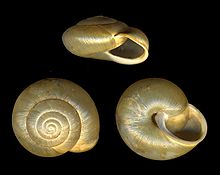
Adaptation
Mesodon altivagus is a terrestrial land snail that has adapted to life on land by locomotion, excretion, reproduction, and behavior. Their mantle cavity is a gill-less, vascularized lung. All have internal fertilization and complete genital ducts. One problem land snails have is controlling water loss, so a humid habitat is favored. A habitat with a lot of available calcium is also important because the thickness and weight of their shell is dependent on the calcium (Wilbur, 1984).
These snails have also adapted through torsion, which is a process that is done during development that twists their body around in the shell. Through the development of torsion, the anus and mouth are located in the same spot, increasing protection from predation. (Hickman et al., 2012).
To increase their locomotion ability, Mesodon altivagus coil their shell, allowing it to be more compact. The method of coiling occurs simultaneously with torsion during development (Hickman et al., 2012).
Above: Mesodon clenchi, a similar species to Mesodon altivagus.
